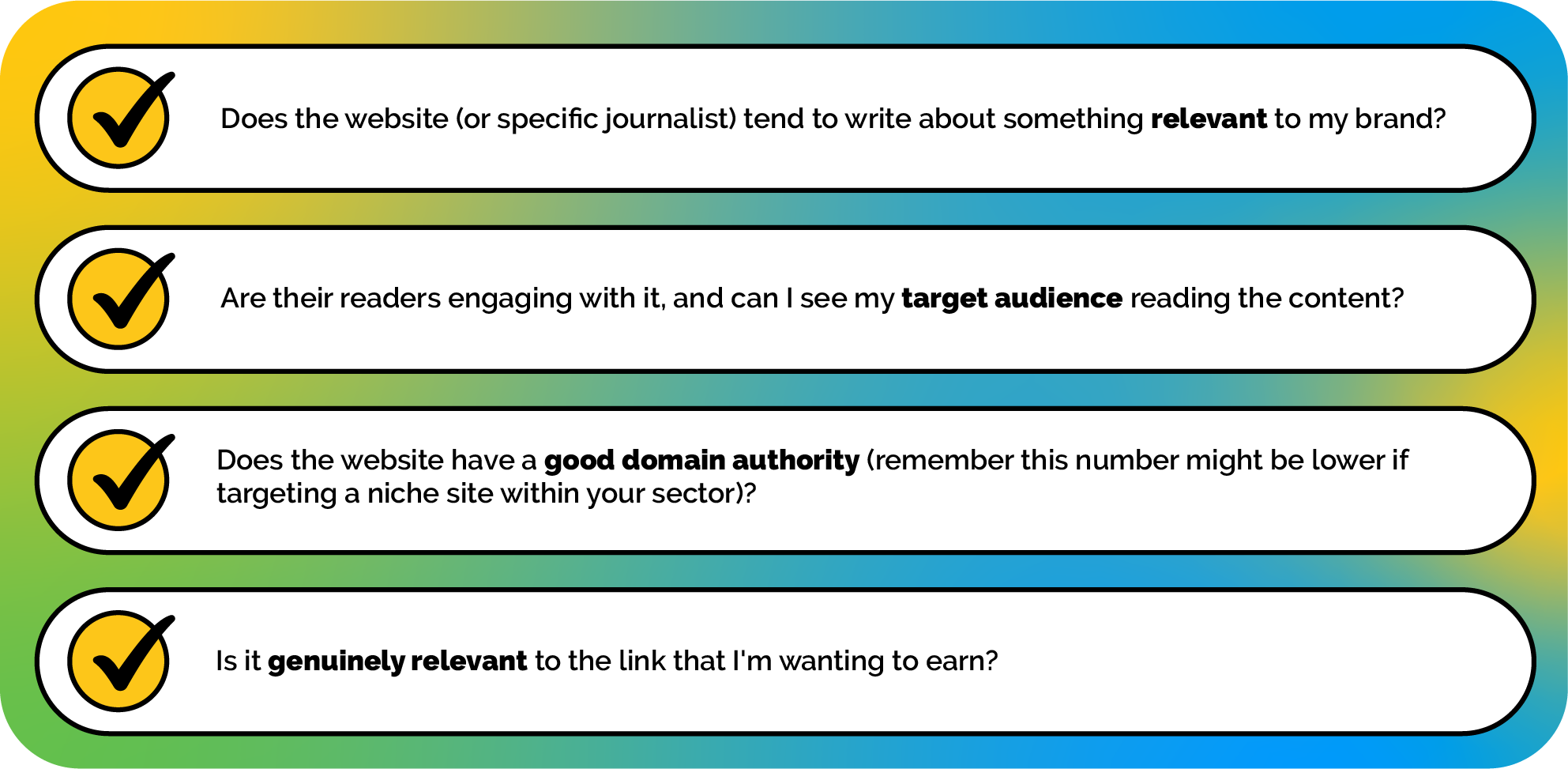Link building: The Backlink Quality Vs Quantity Debate
The hot SEO debate of the decade, and it's a flippin' minefield. Link building (i.e. earning backlinks) is truly at the heart of a Digital PR's job, but so many remain unsure which is the better strategy: backlink quality or quantity?
There's a case for both. Sure, you want to see as many healthy links as possible, but wouldn't it be the cherry on the cake if that backlink profile featured plenty of high DA sites - or brought you referral traffic? Let's dive in and see whether quality or quantity is the key to a successful link building strategy.
In this article:
What are quality backlinks?
Quality backlinks. Does what it says on the tin: these are simply the best kinds of links a brand can earn. Often, this means that those backlinks come from sites with a high domain authority (DA). Even better if they're unique referring domains. But there's a little more to it than that.
Let's start with where the link originates. For a brand that's after high-quality backlinks, some of the most valuable come from the most respected, authoritative news sites. The BBC, MailOnline, Telegraph, and Sky all have dedicated readerships and DAs safely into the 90s and rank highly when Googling terms like 'news' or 'UK news'. A caveat here: high DA doesn't always equal the highest quality; more on that coming next.
Think about the - buzzword incoming - relevance of the website you're building links on, too. If you're an alcohol brand, for example, landing quality backlinks on websites that cover drinks (and probably food, too) are likely to be incredibly valuable, even with a lower domain authority. Consider the site audience; luxury women's and men's lifestyle titles are also likely to be sensible hits. National media, for consumer-facing brands, typically top the list too.
Here's a checklist to help you judge whether a site could play host to a quality backlink for your brand:
Does the website (or specific journalist) tend to write about something relevant to my brand?
Are their readers engaging with it, and can I see my target audience reading the content?
Does the website have a good domain authority (remember this number might be lower if targeting a niche site within your sector)?
Is it genuinely relevant to the link that I'm wanting to earn?
Here’s what you should be thinking about before earning that link. Find out how we benchmark authority for backlinks.
The next thing to think about is the type of link you land:
Follow links (sometimes referred to as 'Dofollow links') tells search engines to follow the link, to consider it as a 'vote of confidence' to your website. These are determined highest quality by search engines. They will do the most to help raise your website's search engine ranking, meaning it will help your site perform better in Google results.
Nofollow links do not pass authority from one site to another. They were originally created to combat spam. They aren't without their rewards, however. We like to think of them as 'good fats'. They're not as powerful as follow links but still contribute to a healthy backlink profile, driving traffic and building visibility and recognition.
Sponsored or Paid links are paid for by the website owners or an advertiser. They include 'rel-"sponsored"' to disclose to search engines that they're not earned. These have their uses, but be very careful when buying links. While some authoritative sites offer paid link building opportunities, many services that promise cheap link building will use sponsored links from low quality websites.
UGC links include 'rel-"ugc"' and are created when users or customers of a website post a link. They can be useful for SEO as they indicate that you have an active community.
Affiliate link-building strategies are usually adopted by consumer brands with e-commerce sites and see the site owner gain commission when products are purchased via one of their links; it works for the right strategy, but traditional link-building tends to favour follow.
You might encounter a broken link too - these are simply links that once existed but no longer do. If you stumble across one, consider dropping the site owner an email to ask to fix it.
The case for high-quality backlinks
If you've read the above, it might already be clear why many marketers - us included - would likely opt for link quality over link quantity. If not, here's what makes quality backlinks important:
Quality links can make your site more Findable
Relevant, authoritative sites that dish out those golden follow links are your best friend for link building. Quality backlinks are always best to boost SEO rankings - or what we call Findability.
Google's Search Advocate, John Mueller, recently advised that quality trumps quantity in SEO inbound link building. He explained that links, both internal and ones that link to your site, should enhance the user's experience or provide additional relevant information. If Google themselves say that relevant, useful links pointing to your site will build your website's ranking, we reckon that's a good reason to listen.
Links from authoritative, relevant sites have a positive impact on your website rankings, meaning you're more findable on search engines, resulting in an uptick in your site's organic traffic when users search for relevant content.
Quality links can also make your site more Famous
Quality backlinks can also make your brand more recognisable, (aka Famous) as well as findable.
Naturally, context is key when talking about relevance. Landing your links within relevant content will bolster its value for search engines. But that relevant context will also mean that readers on that other, related website will likely be interested in what you have to say. It means you'll build recognition for people - i.e. your potential customers - too.
Ensuring your linking is intentional is the other factor to consider. Using the correct anchor text will help; describe your company when referencing the brand, with the link to the site across all these words. For example, we would use 'digital PR agency Bottle' for our anchor text. It helps the search engine - and people - learn more about you.
What does quality link building mean for you?
The end goal here? It's all about signals, and quality backlinks send the best signals to Google. With a dedicated link-building strategy focusing on landing the highest-quality links, you're likely to see a heap of benefits - the biggest (and best) being ranking improvements on search engine results pages (SERPs) and seeing a rise in organic traffic, as more people click on your site.
A healthy backlink profile from a range of relevant, reputable sites means that SERPs are more likely to favour your brand. Climbing Google rankings is no mean feat, so consistent efforts in earning links on relevant sites has a significant impact.
The knock-on effect of quality link building is that your brand becomes organically findable when people Google a related keyword (i.e. your target keywords). The higher you rank in the SERPs, the higher the chance someone clicks on your website. So, with effective, quality link building, your efforts will drive organic traffic to your website. And the more relevant organic traffic you bring to your site, the more conversions you'll see.
The case for high-quantity backlinks
Muddy waters here, but you might think that after all the praise we've given quality backlinks, we'd say backlink quantity isn't so important. But that would be a lie.
Sure, the quality of your links is bound to have a more profound impact on your SERP rankings and the quality of the traffic coming to your site as a result, but quantity has its own role to play in building a diverse and healthy backlink profile.
The fact is, there is a correlation between the number of referring domains your site has and your keyword positions in Google's rankings. Referring domains are simply sites linking across to yours. Getting one link from the BBC is great, but a backlink profile with links from regional news sites, niche subject interest titles as well as the BBC is even better.
You don't need all your backlinks to come from the highest DA sites, but you want to avoid most backlinks coming from low-quality sources, which would lead to the same thing being said about your referral traffic: low quality.
Link building from a strong group of websites and ensuring your link quantity is high means your brand is likely to reach a broader audience. And it's not only the number of referring domains (i.e. other websites) that bolsters your search engine rankings - sheer link volume (i.e the number of links to your site that they post) contributes too.
All these things are great for your SEO strategy when done right. However, the risk you run with the 'quantity' tactic is that you generate links from spammy site owners, which could lead to Google penalties against your site and a drop in rankings. Don't be tempted to choose the 'easy' route of buying cheap links: sudden high volumes of low quality backlinks will signal to Google that you're using spammy tactics, and your site will likely be relegated.
Consider this: is the traffic -i.e. the people coming through to your site - valuable? If the sites linking to yours don't have a relevant, quality audience, then the value of the referral traffic will reflect it.
Your website may already have a ton of URDs and backlinks. Great! But don't get complacent - here's where the freshness of your links comes into play.
Link freshness: why there’s more to link building than high DA
May 2024 saw a Google API leak that gave us some beautiful nuggets when it comes to knowing what Google sees as valuable. It confirmed - as we all probably could have guessed - that links remain an important factor for SEO, with metrics like sourceType indicating the value of links based on where a page is indexed (hello quality). The OnSiteProminence variable suggests links from new, trusted pages, and link freshness matters too (bonjour quantity).
It's not enough anymore to rely on historic backlinks to keep you up the top of the rankings and drive traffic to your site. You need to continually build backlinks on a range of sites to continue to reap the rewards of those links - and that's why your digital PR strategy is so important; it's about so much more than earning links wherever you can. Relationships are key.
PRs, first and foremost, rely on building relationships with journalists and bloggers to drive repeated coverage. It's always link-first with PR for SEO (Findability), so having a dedicated team with those all-important media relationships (that often means we can be more direct with where we'd like a link to be directing readers to) is crucial and often means that we can pursue quality and quantity when we build backlinks.
How we get the best backlinks for your goals
How we determine targets for link building
Search engines are often our best friends when it comes to determining targets for link building; keyword research into relevant areas for a client will often reveal which media titles and blogs cover relevant subjects for our clients to feasibly offer data, tips or expert commentary with which we can build high-quality backlinks.
For a pet food brand, for example, we'll look into the generic 'dogs', 'dog food' 'dog health' keywords - which often result in mainstream media results - alongside the PR tactics we know media love, like 'vet's warning' or 'dog expert warns' or 'I'm a dog expert', which will reveal our target media titles.
Using a tool like Ahrefs or Semrush - and with a little knowledge of competitors - backlink analytics and competitor backlink gap reports give us a more comprehensive media list. Not only are we equipped with a long list of URDs - which we already know to determine high-quality backlinks - but we can also knock some of the shine off a competitor's link.
Our link building strategies, in a nutshell
A good link building strategy can combine link quality AND quantity, but a focus on quality backlinks can often mean that quantity comes in tow. This is how we ensure most links are quality when we're building backlinks.
1. The '10x content' approach
Sometimes this is referred to as the 'skyscraper technique' - but we, ironically enough, take it to the next level.
The skyscraper technique is a popular SEO tactic that identifies the top-performing existing content on a subject and seeks to do one better. You might wonder, 'Does the skyscraper technique work?' and truthfully, yes - if the 10x approach is applied.
Just outperforming the competition isn't good enough; the 10x principle seeks to do 10 times better than anything already existing on other websites - a real step up from other resource pages. It means that when someone does a simple Google search, our content will likely appear at the top of the search engines' rankings.
This often means creating ultimate guides on a subject relevant to your brand and use them as a base for building high-quality links - but it can be other forms of content, too. When most SEO tactics will make new content that's inspired by the 'best of' the rest of the internet, we get more creative. We recognise what your brand is an expert in, and make resources that stand out.
Often, this will look like an 'ultimate guide' - but we seek to make the right content experience for the customer, so it depends. Search engines love when you publish 'ultimate guides', however, and the chances are authoritative sites will give you links in return for providing a genuinely helpful experience for their readers.
In true Blue Peter style, here's one we made earlier:
For dog food brand Harringtons, we earned nearly 300 backlinks on more than 200 URDs with a complete guide to dog walking. The guide broke down advice by dog breed, age and size, which saw the brand ranking for over 200 new keywords and organic traffic rise by nearly 50%.
Optimising your guide for your keyword targets will ensure you're using the right long-tail keywords and phrases within the blog posts to rank for new terms and outperform competing existing content and relevant resources.
The key to the strategy is telling relevant stories in your link-building campaigns. Tap into popular PR tactics - like little-known laws or warnings from authoritative expert voices - that tie in nicely to the guide. We found that there are pretty strict laws on what must be on a dog's collar tag and landed more than 100 pieces of coverage that link back to the guide with relevant anchor text. Think of it as providing additional resources to the stories you tell to media.
2. The irresistably linkable approach
When making new pages for your website to drive links towards, most SEO marketers will look for current keyword opportunities - i.e. what people are Googling right now - to target. But what if the "internet thing" your customers need isn't out there yet?
We believe that by getting under the skin of our clients' customers, we can create new web experiences that solve for them in new ways.
This means we're exploring new angles and often building pages with interactive elements, such as tools, gamified content, or content that's changeable, to keep people coming back. It could also be a comprehensive resource that tells a story in multiple sections.
Here’s an example from our own site.
Our How Many People tool is an interactive calculator that helps you visualise Reach. So instead of meaningless numbers, you can translate your metrics into something more relatable.
If users keep returning to your website - and spending a long time on your page - this is seen as a real plus in Google's eyes, meaning your overall site is rewarded in search results. It also puts you way ahead of the competition because no one else is doing what you do. So, you're ahead in your customers' eyes, too.
It's not just the SEO potential of these assets that's killer for link-building strategies - the media LOVE them. The link becomes irresistible to a journalist or blogger when the contents do something that couldn't be replicated on their website. Interactivity is often the clincher for this. For example, an interactive map with pop-ups when areas are clicked isn't something journalist can easily place within their article. It makes sense that they'd link to your site to take their reader towards your resource page. It's great for building relationships, as journos look out for the innovative stories we're telling.
These 'irresistible reasons' also mean you're less likely to face a broken link later down the line. If you earn links that are important to their story, they won't remove it. Which means less time chasing broken links - and more time
3. The 'brand-spanking new data' approach
'New news' is something any PR will be accustomed to and offers plenty of link-building opportunities.
To earn high-quality backlinks from authoritative news titles, brands must create genuine news to cover. Research reports are a great way of doing this, and new research doesn't always mean investing in a survey as with typical news generation. Digging into existing data sources to inform research can form the base of a successful link-building campaign; some of the best for UK media include the Census (most recently undertaken in 2021) and the Office for National Statistics, with details on pretty much all aspects of life in Britain.
Our speciality at Bottle is combining data in new ways to tell unusual stories that make people stop and think.
This is a tactic anyone can use - whether you're a small local business or a large corporation - and is a great way to offer a point of difference while illustrating your expertise. Using this data for an onsite experience offers insight that other websites won't have, and using it for an offiste PR story to build links will help strengthen relationships with press and earn you a reputation for interesting insight.
Data storytelling adds your brand to the news agenda when done right, and can lead to seriously high-quality links. Hosting your research findings on dedicated resource pages or blog posts gives the most natural reason for a journalist to include contextual links in their write-up, but homepage links are essential in any strategy too. Read more about data storytelling in our blog post.
The “new data approach” isn't the only story-making feather in our cap. Talk to us about our Digital PR capabilities and we can show you more ways we capture the press' attention.
What about guest blogging?
Many SEOs see guest post strategies as a key part of link building. You'll see plenty of sites advising "write guest posts!" alongside "write to website owners and ask for a link!" and broken link building - i.e. penning emails with the aim to fix broken links - as their principal advice for link building. But we know there's more to it than that.
Guest posting involves writing an article or blog post on another website in exchange for a link to your own site.
However, much like simply writing to website owners asking "please!" (which will be ignored in 99% of inboxes), guest posting is very time consuming and often not hugely rewarding.
It can be done right: a high quality blog post published in a relevant, high authority website that can drive traffic while boosting your appearance in search engine results pages is possible to achieve. But if you're going to the effort of finding or making a story, most of the time it's the press who will be best placed to help you tell it.
The tactics for writing successful guest posts are very similar to traditional PR: you need to research the publisher, personalise your pitch, and engage with your audience. We also use our writing chops for winning press releases and stellar onsite content to link to. But if you can land your story in the press, your link often means much, much more.
Quality backlink strategies: delivering the best impact for your brand
That was a lot to unpack. All these strategies aim to drive real quality backlinks, but the principles still apply to quantity if that's your goal.
If the time is invested in building quality backlinks, the quantity often comes by itself. A combination of a search and reader-first approach to onsite content will mean a healthy backlink profile and an even spread of link equity across your site.
A good SEO strategy will always include digital PR; together, you'll reap the rewards of a shit-hot website and nurture long-lasting relationships with journalists, leading to link freshness, quality AND quantity.
Get in touch to learn how we can transform your backlink profile and make your brand shine in the process.






